Ralpie Wants to Walk Again Watermellon Ranch
I surveyed five specialty cutting-flower growers, all members of Slow Flowers, to glean from their experiences and insights. What you'll read here is collective and cumulative wisdom that adds up to three-quarters of a century of farming and selling flowers.
The following advice comes from Charles Little of Eugene, Oregon-based Charles Little & Co; Laura Mewbourn of Banquet & Flora Farm, based in Meggett, Due south Carolina; Janis Harris of Harris Flower Farm in St Thomas, Ontario, Canada; Ralph Thurston and Jeriann Sabin of Deadhead Cut Flowers (former owners of Bindweed Flower Farm) in Blackfoot, Idaho; and Melissa Garcia Parry of Howl & Whistle Flower Farm, also in Eugene, Oregon.
Without hesitation, blossom farmers cite a publication from the Clan of Specialty Cut Flower Growers as their go-to reference: Postharvest Handling of Cutting Flowers and Greens. Subtitled A Practical Guide for Commercial Growers, Wholesalers, and Retailers, the volume is "a must when I have a new crop I'm harvesting," says Laura Mewbourn.
As a farmer–florist, Laura's take on the "grown non flown" mantra is twofold: "The biggest selling points for my flowers are that I am growing things that don't send well or tin can't be purchased from the wholesaler at all, and that I deliver all of my product in considerably meliorate status than most of what has been shipped dry."
Janis Harris echoes these sentiments on the value of locally-sourced blooms: "We make sure that we brainwash our customers and sell them the right flower for their needs," she says. "A bride needs her bouquet to look perfect for a few hours, so we are able to use more unique stems that have shorter vase life. And a market place bouquet has to be filled with longer-lasting flowers, so they will bloom for the friend in the hospital or the grandma living in a nursing home."
What to Grow
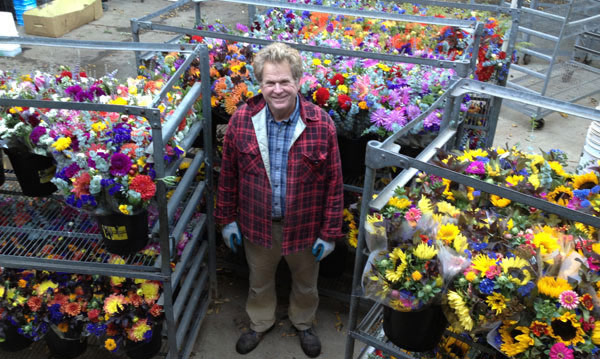
Grow something out of the ordinary, of unmatched quality, in ample quantity.
The recipe for a successful crop mix is as varied equally flower farms themselves. Key considerations include the amount of acreage you have available to you as well as what you similar to grow.
Charles and Bethany Little are veteran growers and certifiable institute lovers. They write this on their website's "about" page: "Height florists and wholesalers are forever hungry for something unique, something they have never seen. It'southward our job to provide these kinds of flowers in both quantity and unmatched quality."
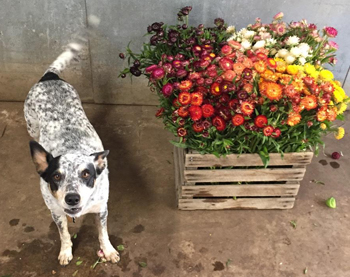
Remy & the Everlastings
Grow what you lot can arrange, grow what you dear.
When Charles began the subcontract in 1986, he originally grew "everlasting" flowers for the arts and crafts market. Later, with changing customer preferences, he and Bethany transitioned to herbaceous and woody crops, although they did not abandon the annuals that dry well.
"I nevertheless love the things that give yous ii or three opportunities to harvest," Charles says. "Whether it's the blossom in the spring or the pod in the fall, it'due south e'er cracking to take some kind of backup plan for a flower. Certainly, we grow statice, ammobium, and strawflower… all are great dried flowers, but they're most better equally cutting flowers."
Charles is ever on the lookout for something new and unusual to satisfy customer demand. "It's and so of import for growers to ignore what the competition is growing and written report the seed catalogs, read the trade journals, wander around garden centers and nurseries and fifty-fifty through people's yards. That's the style to detect things that no i else is growing."
When to Harvest
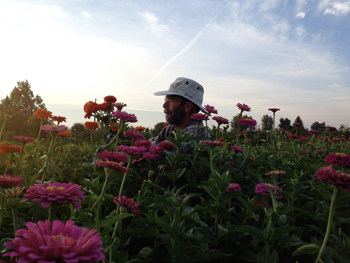
Harvest when oestrus and wind are at their nadir — peculiarly in hot, dry climates.
In Blackfoot, Idaho, Ralph Thurston and Jeriann Sabin are transitioning from owning and operating Bindweed Flower Farm to writing and teaching through their new business organisation, Deadhead Cutting Flowers. That'due south also the proper noun of Ralph and Jeriann'south first book, which is filled with the kind of lessons you lot only learn later blossom farming for nearly three decades (Ralph has just issued a second book titled All Pollen, No Petal: Behind the Flower Farming Dream).
Ralph and Jeriann have a lot to share about blossom-farming best practices. The twenty-four hours I spoke with them by phone, Ralph confessed that while supposedly "retired," he still wakes at 4am to assistance Bindweed's new owner, nephew Ben Josephson. "We harvest every twenty-four hours, and some flowers must exist checked and harvested several times a twenty-four hour period," he says. "If flowers are harvested at their peak time and properly conditioned, they will hold better for both the farmer and for the client."
That means harvesting early in the morning, before the oestrus of the day causes flowers to lose moisture and brainstorm to dehydrate. "This is particularly crucial in hot, dry out climates like ours," Jeriann explains. "It really needs to exist absurd, so that means earlier sunup, with a headlamp. If yous harvest early on when that found is nonetheless vigorous, y'all're getting a better production."
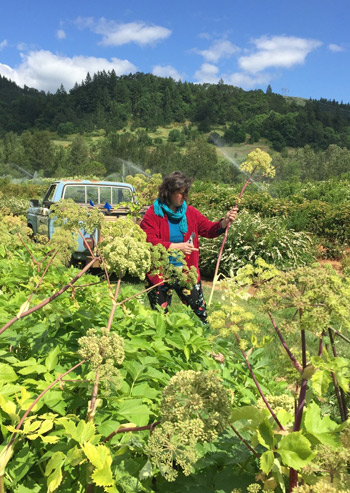
Discover and experiment with what's best for your own particular zone/microclimate.
While the climate of South Carolina'southward Low State differs markedly from the loftier desert of Idaho, hydration is as of import on her farm, says Laura Mewbourn. "Our summertime rut is brutal, and so flowers get harvested every bit early or every bit late every bit possible — then popped directly into the cooler. My flowers are never out of water. I'thou mindful about making certain my buckets are clean, and I employ alcohol wipes on my clippers when necessary. Overall, I think it'southward well-nigh important to develop a researched and consistent practice in harvesting."
Charles Petty & Co. employs a pocket-size crew to harvest their flowers. While doing so early in the forenoon is important, Charles will often first the coiffure'south twenty-four hours with weeding for a few hours before harvesting.
"Typically, crops are soaking wet at daybreak, but one time the sun is out and the wind has picked up, the flowers starting time to dry off. So, a typical procedure is for us to weed from vi to 8:30am, and so switch to harvesting until i or 2pm," he explains. Sometimes it's raining: "Everything's moisture, then before we can put that production in the cooler, we have to clean the stems and lay it loose on a cart and run our fans," he explains.
The differences between harvesting practices in Western Oregon, where there are dewy mornings and Blackfoot, Idaho, where flowers rarely feel dew illustrate how site-specific each farm can be — and consequently how important it is to observe and experiment with what'southward best for your own item zone/microclimate.
Bucket Care
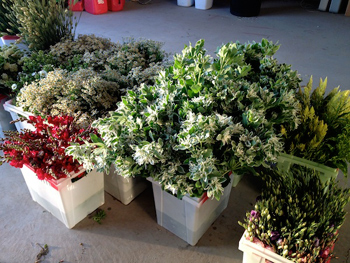
Harvest flowers at their superlative readiness, with speed and make clean tools, water, and buckets.
It nigh goes without saying: Harvesting into clean buckets equals a superior botanical product.
"Post-harvest practices take time to get a handle on," says Janis Harris. "I think the water source is very of import. We are blest with a very deep, very clean well. Everything on our subcontract is harvested and immediately placed into a bucket of clean, common cold water."
Jeriann Sabin and Ralph Thurston maintain that it may not be necessary to haul buckets of water out to the fields for harvesting. "There is no need if yous are harvesting at the proper fourth dimension of day, if it is cool and the flower is completely hydrated during the dark (so it is full of wet and nutrients). Ralph is lightning fast — Samurai fast," Jeriann jokes. "There is a ticking time bomb in his head — he cuts all that he can for 10 minutes and gets that up to the befouled and into h2o; then he heads out for more."
And while they hear about bloom farmers who invest in plush "bucket-washing stations," Ralph and Jeriann are large believers in simple tools and elbow grease. "We have a hose and a corral brush," Jeriann says. "We do not let buckets sit down more than than one week before washing them out. Y'all just have to do the work, especially so yous're delivering flowers in clean buckets, with freshly conditioned h2o and fresh cuts on the flower stems."
| Jeriann & Ralph'south Saucepan-Washing Formula | ||||||
|---|---|---|---|---|---|---|
| For each saucepan, use: i GALLON Water + i GOOD SQUIRT DISHWASHING LIQUID + i "Large GLUG" BLEACH | ||||||
| Stride 1 | Stride 2 | Step 3 — For Really Scary Buckets | ||||
|
|
| ||||
Holding, Storing, Refrigeration
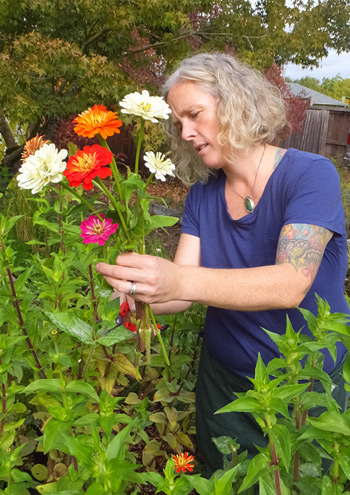
Adding refrigeration in her 3rd yr of blossom farming was a game-changer for Melissa Garcia Parry of Howl & Whistle Flower Farm.
Flower farmers hold that refrigeration is essential. Even though she actively grows on about ⅛-acre in her urban neighborhood, Melissa Garcia Parry of Howl and Whistle says that adding refrigeration in her third yr of flower farming was a game-changer for productivity, efficiency, and profitability.
Rather than investing in a walk-in cooler or CoolBot organization, Melissa converted 2 chest-style freezers with an adaptor that controls temperatures, keeping them at just below 40°F/4.iv°C. "They have revolutionized my life," she maintains. "I've at present been able to harvest on Thursday and concur things for a few days, before going to the Saturday Market. I'm merely one person and I do cutting into water, but now I tin harvest and bring my flowers into the 'Kegerator,' which is what the system is called."
Afterwards growing flowers for a decade, Janis Harris insists that "100%, a cooler is a must! Nosotros tin can selection flowers all week and either hold them until the weekend or use them during the week. Because my flowers are in a libation, I feel less urgency to unload them; I can sell them when I want to."
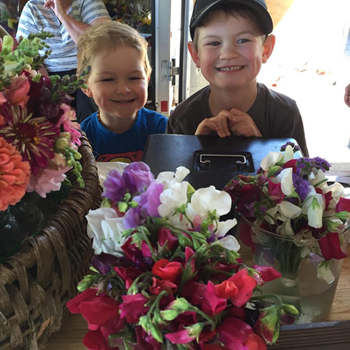
Janis of Harris Flower Farm is experimenting with flower-food recipes for the get-go fourth dimension this season. Although her flowers take done well in the by without it, "We'd similar to see if it improves the life of our flowers," she says.
Janis says she's experimenting for the start time with various flower-food recipes this season. "Our flowers have e'er done very well in the past, so nosotros didn't use flower food. But we'd like to encounter if it improves the life of our flowers. I likewise use a one-half-cap of chlorine bleach in zinnia and sunflower buckets."
Charles Niggling agrees that his farm's 12x24-human foot walk-in cooler is an essential flower-farming tool. "It's then typical for our coiffure to come up in from the fields at 2pm, and despite all the endeavor we made to get those flowers cut and into h2o apace, placed in the shade or in the truck under the canopy, those flowers expect wilted. It requires confidence to know that afterwards getting them into the cooler, they're going to perk upward and everything will be fine past the next morning." Charles and Bethany do not use floral preservative or flower food. "For things we think need a little actress something, we might add a chlorine pill. For the woodies, we similar to use Quick Dip."
Selling to Florists
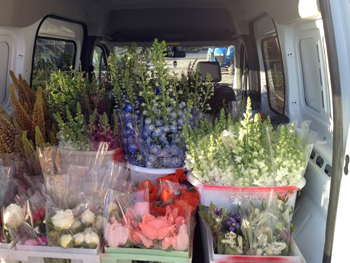
"Visually," notes Jeriann of Deadhead Cut Flowers, "everything on my truck looks alive and fresh; the flowers are deeper and richer in color; the petals often have better texture…" And then, there is fragrance: "When I open my truck doors, I can smell the flowers."
Ralph and Jeriann built Bindweed Flower Farm selling their flowers directly to florists in Lord's day Valley, Idaho and Jackson Hole, Wyoming — markets located over 2 hours away from their subcontract. "We don't have refrigerated trucks, merely our flowers come right out of the cooler and into a cool truck," Jeriann says. "And I practise run the A/C while driving our deliveries."
Every bit a result of proper harvesting and processing, the flowers make it in splendid condition, she says. "I am constantly observing and gathering details on what my clients are using, what'south coming in from large wholesale entities, then I can frequently exercise a side-by-side comparison. Visually, everything on my truck looks alive and fresh; the flowers are deeper and richer in color; the petals often accept better texture. Even overnight boxes from good companies cannot compare — they look dehydrated because they are. When I open up my truck doors, I can smell the flowers. Each 1 has been harvested properly at its peak harvest moment. I always experience comfy guaranteeing our flowers for a week to ten days, if handled correctly. Only I make information technology a policy to know my clients and often, what they are using the flowers for. Their reputation (and ours) is riding on our product.
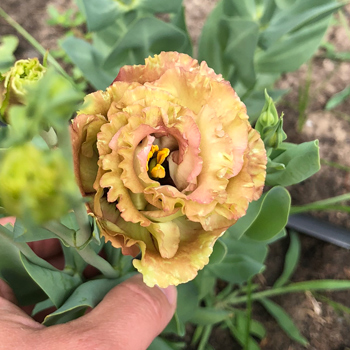
Laura Mewbourn of Feast & Flora Farm believes in delivering infrequent value. She will do some or all of the processing unremarkably required by her designer client before she delivers their flowers, and volition besides add a few extra stems.
Laura Mewbourn, of Banquet and Flora, knows what's information technology like to receive poor quality flowers from a supplier for her design work. "From a designer's perspective, receiving a bunch of flowers with several unusable stems — or worse, an entire bunch that shatters — is heartbreaking, and oftentimes results in a last-minute scramble to notice replacements. I don't want that to happen to my clients with my flowers, so I do some or all the processing that is ordinarily done by the designer afterwards receiving shipped flowers. I desire the designer to have to practise less when she or he receives my product."
Laura likewise adds a few extra stems earlier delivering to florists. "I've certainly never received an extra stalk from the (conventional) wholesaler, but information technology is worth the extra modest amount of money on my part to ensure that my clients are getting what they paid for."
Selling at Farmers' Markets
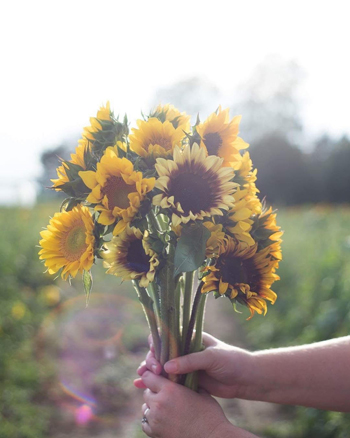
Customers appreciate learning about the flowers they purchase: "Nosotros tell [them] nigh the harvesting stage (petals just lifting compared to blown wide open up) and multifariousness selection (pollenless, potent petals/stems, cutting varieties), so they know why ours are superior," says Janis Harris of Harris Bloom Farm in Ontario, Canada.
Consistency and constant advice with customers are among Harris Flower Subcontract's all-time marketing strategies, Janis says. "Our customers are accustomed to receiving high quality flowers from us. Nosotros've built our business over the past 10 years, and people know what to expect. Our flowers may run at a college price-point than our competitors', but we continue to add new and better flower varieties to our lineup that others don't grow. There may be another vendor at our market who is selling sunflowers for much less than we are. We tell the client about the harvesting phase (petals just lifting compared to diddled wide open) and variety selection (pollenless, potent petals/stems, cutting varieties), and so they know why ours are superior. Often the customer will come back on some other market day to thank us for educating them, and tell us how much they enjoyed their flowers."
Keeping flowers fresh at the farmers' market is a abiding challenge, Janis continues. "When we are selling at a marketplace, the bouquets are always kept in a shady spot, such as under a awning or tent — never in direct sun."
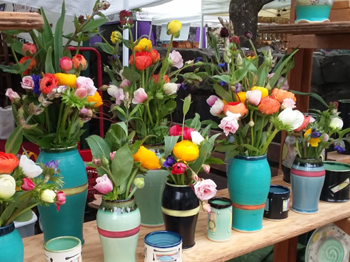
Melissa, of Howl & Whistle says, "I like to help people understand that I'one thousand the person who grew this bloom. Information technology's hyper-local, from two miles away."
Laura Mewbourn says, "I know some farmers put frozen h2o bottles in their flower buckets to keep them absurd at market place. Others have rigged up defunction, sometimes fifty-fifty fabricated from the shade fabric nosotros use in the field, to block wind and light."
Melissa, of Howl and Whistle, shares a covered stall with her husband Dave Parry, a potter and possessor of Whistle Postal service Pottery, at the all-day Saturday Market in Eugene. They ofttimes switch sides during the mean solar day, following the shade (for flowers) and the sun (for pottery).
"I like to help people understand that I'k the person who grew this bloom. It'due south hyper-local, from 2 miles away. I finish up recognizing repeat customers and having conversations about my flowers and my growing practices," she says. Recently, when a shopper mentioned trying to decide between ownership Howl and Whistle's flowers or picking up flowers at Trader Joe'south, Dave was quick to ask, "Practise you want to support someone who farms a couple of miles away, or a large corporation whose flowers come from who knows where?" The customer "bought two bouquets and went away happy," Melissa adds. "I realized that I've assumed people make supporting locally-grown flowers a priority, forgetting that the layperson may not even recollect nearly that. It's a reminder to have conversations, keeping information technology low-cal and educational, and say, 'Hey, I grew all of these flowers.' "
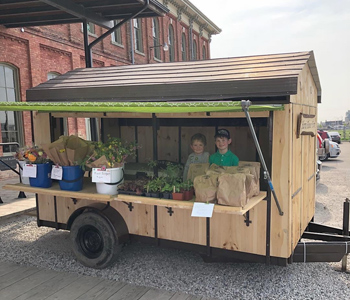
For Janis of Harris Blossom Farm, keeping flowers in the shade is essential. Her dad recently built her this mobile cart with a canopy.
"I absolutely talk with my farmers' market and retail customers, about how to ensure their flowers last as long as possible," Laura says. "I also advise them on the vase life of private varieties. Customers are wowed by dahlias, for instance, only don't necessarily know why they don't last every bit long equally a zinnia. I hope I'one thousand educational activity my retail customers to capeesh a wider range of flowers and to understand that fifty-fifty subsequently they're cut they are a living thing that needs to be treated well to remain lovely as long as possible."
For Janis, keeping flowers in the shade is essential. "The deciding factor when nosotros are presented with a new market is whether there is some type of covering. This past winter, my dad built a mobile bloom cart from an former livestock trailer for u.s., fashioning it with a adept canopy cover to shade the flowers. Nosotros use it for transporting and displaying flowers at markets and events."
RALPH & JERIANN'South FLOWER CARE GUIDE
for marketplace customers
- Make a fresh cut in each stalk.
- Strip off any foliage that will prevarication below the water line.
- Go on your vase every bit clean as you would your wine glass or tea cup!
- Make sure your bouquet sits out of direct sunlight & drafts.
- Replenish water every mean solar day or two.
She sends farmers' market place buyers home with bouquets wrapped in a small baggie filled with water for the trip dwelling house. "Then, in conversation, we say, 'Make sure to modify the water every couple of days. Flowers like clean, cool water, so don't display them in a window where the sunday will rut up that h2o.' "
Back when they sold at farmers' markets, Ralph and Jeriann stapled a 'care guide' to their flowers. "It recommended making a fresh cut; stripping off leaf that'southward under water; keeping vases every bit clean as you would your wine glass or tea cup; and making sure your bouquet sits out of straight sunlight," Jeriann says.
The Good, the Bad & the Best-Sellers
I asked all the farmers to name some of their favorite and not-so-favorite flowers. You may be surprised past what they shared!
Crops you love to grow because they hold up well
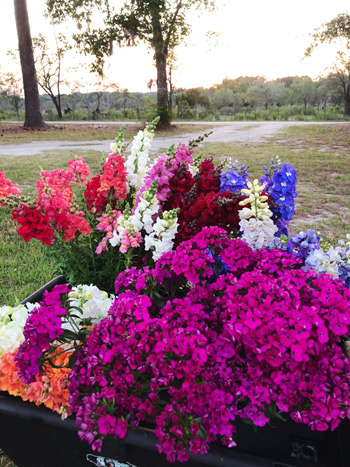
"My 'Amazon Neon Imperial' dianthus has an amazing vase life," notes Laura of Feast & Flora. "[T]he 'Chantilly' and 'Madame Butterfly' Serial snapdragons are popular with my design clients and florists alike, and after i calendar week, they are notwithstanding holding their color so well."
- Jeriann & Ralph: Sunflowers, tulips, asclepias, bells of Ireland, phlox, sage, raspberry and blackberry foliage, viburnum, and delphinium.
- Melissa: The 'Chief' Serial of celosia. "It stops people in their tracks and they want to know what it is — which allows me to have a chat," she says. "It doesn't wilt or droop, and I was able to dry anything that didn't sell and make it into velvety Christmas wreaths. I feel like a genius getting a 2nd product out of it! I besides love zinnia 'Queen Red Lime' and others in the series. They are serious workhorses and they go so much attention from customers." Scabiosa and strawflowers are two other favorites. "Their novelty at market place is a reward for the sweaty days of harvesting."
- Janis: Lisianthus. "We love information technology for wedding work, and customers beloved it considering information technology has such a long vase life."
- Laura: "I love to grow zinnias, particularly the 'Benary'south Giant' Series for their amazing vase life. It's not unusual for a client to report their bouquet still looks beautiful later on a week or ten days. I have a growing collection of heirloom chrysanthemums — their staying ability is positively bionic, and their unique colors are appreciated by fifty-fifty the nigh avid mum hater. My 'Amazon Neon Purple' dianthus has an amazing vase life — 10 days or more — so information technology's gotten a lot of play in my arrangements. It's also hard to go wrong with any of the snapdragons — the 'Chantilly' Series and 'Madame Butterfly' Serial are popular with my design clients and florists alike, and after one calendar week, they are withal belongings their colour then well."
- Charles: "I love to grow crops that you can only 'rake' when harvesting. Like lavander — you can simply take hold of it and hack away at information technology. I also love the direct-sown varieties, such as foxtail grass, millet, sunflower, zinnia, safflower."
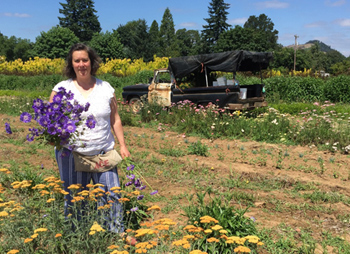
The tedium of harvesting scabiosa tin can be minimized, find Charles & Bethany Little, by lining stems up at their bases rather than their heads, then sorting them mail harvest. Setting a higher price point for them will cover whatsoever actress time they may require in handling.
Crops y'all love less, because they're fussy (just important to your customers)
- Jeriann & Ralph: Clematis, because it needs to exist netted and is fourth dimension-consuming to harvest considering of intertwining vines.
- Melissa: "Final yr, I felt like every unmarried aster was triple the work. I don't know if they're extra needy or if I'g just bad at growing them, so I've simply taken them out of my rotation this year."
- Janis: "I shouldn't say I hate zinnias, only they are frustrating. They don't like the cold temperatures of the cooler, just warmth makes the water go funky chop-chop. Zinnia meltdown seems to be a common trouble. It'south a flower that has to be picked and sold quickly, too. Information technology takes some practice to teach or empathize the 'jerk test': When I am picking the flower, I requite the stem a quick jiggle to see if the bloom wobbles. If it wobbles, it isn't ready. If it's stiff, it's ready to pick."
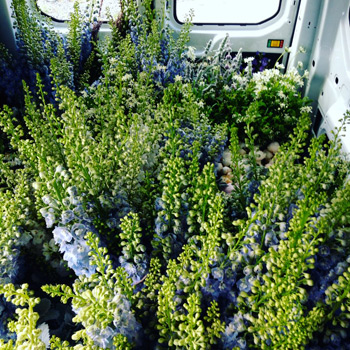
"The key is quality," notes Jeriann of Deadhead Cut Flowers, "and driving home the superior quality of your product."
- Laura: "My honey-detest flowers are probably the same as most designers: poppies and dahlias, both of which are then beautiful and and so finicky. I'll never terminate growing and using them, but I don't include them in my weekly subscriptions. I save them specifically for special occasions and events."
- Charles: Scabiosa. "They're tedious to harvest, so it's a complicated crop. Merely it'southward so pop and piece of cake to sell. We have raised our price on it, and customers still buy information technology. When harvesting, instead of lining up the heads (to have a uniform agglomeration of stems), we line up the base of the stem to make the bunch. It's irregular; short stems are mixed with alpine stems, but it gets cut, put in h2o and into the libation. Later, every bit we process for orders, we sort and form past stem lengths."
After spending time with each of these inspiring flower farms, the all-time advice I heard tin exist distilled into "Find what works for you. Then continue experimenting and improving."
"The key is quality," says Jeriann. "And, driving habitation the superior quality of your product."
"My florists absolutely recognize a higher-quality production when they see it because they see production of all levels all twenty-four hours long," Laura points out. "I've heard squeals when I bring in buckets of my flowers, which lets me know I'm doing my job well. My retail customers know that my flowers tend to final longer than what they can get from a grocery store, and so they really appreciate feeling like they've received practiced value from their buy."
Acquire More
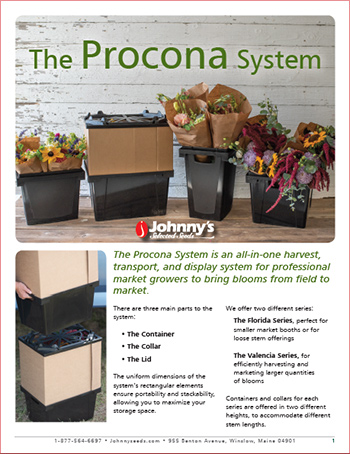
- 5 Factors That Determine the Vase Life of Cut Flowers • Article
- Postharvest Treatment of Cut Flowers and Greens: A Practical Guide for Commercial Growers, Wholesalers, and Retailers, by John Dole, NC State Academy; Robert Stamps, University of FL; Alicain Carlson, NC State University; Iftikhar Ahmad, NC State University & Academy of Agronomics, Faisalabad; Lane Greer, OK State University; Judy Laushman, Editor. Published past ASCFG • 360-pp Book
- The Procona System: An economical, recyclable, lightweight, all-in-one system for harvesting, postharvest treatment, transporting, and marketing of cut flowers and leafage • 4-pp Brochure
richmondtamet1951.blogspot.com
Source: https://www.johnnyseeds.com/growers-library/flowers/flower-farming/cut-flower-harvest-post-harvest-care.html
0 Response to "Ralpie Wants to Walk Again Watermellon Ranch"
Post a Comment